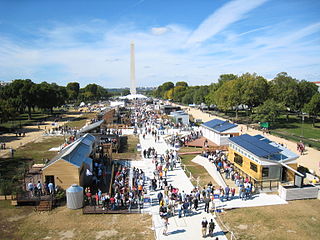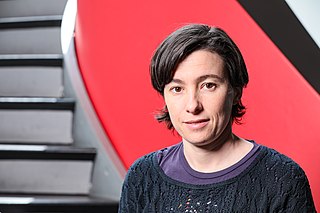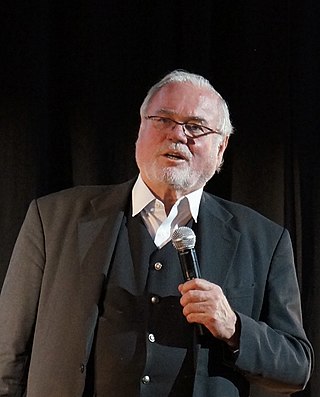
The École polytechnique fédérale de Lausanne is a public research university in Lausanne, Switzerland. Established in 1853, EPFL has placed itself as a university specializing in engineering and natural sciences.

The U.S. Department of Energy (DOE) Solar Decathlon is a collegiate competition, comprising 10 contests, that challenges student teams to design and build highly efficient and innovative buildings powered by renewable energy. The winners will be those teams that best blend design architectural and engineering excellence with innovation, market potential, building efficiency, and smart energy production. In the summer of 2018, DOE merged its two student building design competitions into one Solar Decathlon competition.

Patrick Aebischer has been the president of the École polytechnique fédérale de Lausanne (EPFL) from 17 March 2000 to 31 December 2016. He is also a professor in neuroscience and head of the Neurodegenerative Disease Laboratory at the EPFL.
The 2000-watt society is an environmental vision, first introduced in 1998 by the Swiss Federal Institute of Technology in Zürich, which pictures the average First World citizen reducing their overall average primary energy usage rate to no more than 2,000 watts by the year 2050, without lowering their standard of living.

Science and technology in Switzerland play an important role in the Swiss economy, which has very few natural resources that are available in the country. The Swiss National Science Foundation, mandated by the Federal government, is the most important institute for promoting scientific research.
The Holcim Foundation for Sustainable Construction is a non-profit organization. Its goal is to raise awareness of the role that architecture, engineering, urban planning and construction have in achieving a sustainable built future. The organization encourages and rewards sustainable responses to the technological, environmental, socioeconomic, and cultural issues affecting building and construction. The Holcim Foundation for Sustainable Construction promotes thought leadership on a greener, smarter, circular, and more inclusive built environment.

The SwissTech Convention Center is a conference centre on the campus of the École polytechnique fédérale de Lausanne (EPFL), Switzerland.

The Lausanne campus or Dorigny university campus is a large area in Switzerland where the University of Lausanne (UNIL), the École polytechnique fédérale de Lausanne (EPFL) and several other institutions are located. It is in Dorigny, towards the west of Lausanne, on the shores of Lake Geneva. The site is about 2.2 kilometres wide and 31,000 people study and work there.
The Health Valley covers the Western Switzerland region, where the life sciences sector extends from Geneva to Bern, including the seven cantons of Bern, Fribourg, Geneva, Jura, Neuchâtel, Valais and Vaud. This cluster presents a critical mass of 1,000 companies, research centers and innovation support structures, representing today more than 25,000 employees. The Health Valley strives to animate the life sciences ecosystem of the region, by establishing thriving bridges between its ambassadors.

Switzerland Innovation, organised through the Switzerland Innovation Foundation is the Swiss national network of science parks.

The Adolphe Merkle Institute (AMI) is a research center in Fribourg, Switzerland focused on nanoscience. The institute is named after the Swiss entrepreneur Adolphe Merkle who created the foundation that partially funded the institute.
cadwork informatik AG is a multinational software company headquartered in Basel, Switzerland. It develops and markets software products primarily for the construction industry. These products include timber industry products in computer-aided design (CAD) and computer-aided manufacturing (CAM) as well as products in building information model (BIM) and virtual design and construction (VDC). These products are suitable for designers, structural engineers, construction engineers, civil engineering draftspeople, building contractors, and in the case of BIMTeam VDC, the construction crews.

Carmela González Troncoso is a Spanish telecommunication engineer and researcher specialized in privacy issues, and an LGBT+ activist. She is currently a tenure track assistant professor at École Polytechnique Fédérale de Lausanne (EPFL) in Switzerland and the head of the SPRING lab. Troncoso gained recognition for her leadership of the European team developing the DP-3T protocol that aims at the creation of an application to facilitate the tracing of COVID-19 infected persons without compromising on the privacy of citizens. Currently she is also member of the Swiss National COVID-19 Science Task Force in the expert group on Digital Epidemiology. In 2020, she was listed among Fortune magazine's 40 Under 40.

Claudia R. Binder is a Swiss, Canadian and Colombian environmental scientist working in the field of human-environment systems and sustainability s. Since March 2016 she has been a full professor the La Mobilière Chair on Urban Ecology and Sustainable Living at École polytechnique fédérale de Lausanne (EPFL) in Switzerland and founding director of the Laboratory for Human-Environment Relations in Urban Systems (HERUS) at School of Architecture, Civil and Environmental Engineering (ENAC) of EPFL. Since January 2020 she has been serving as dean of ENAC at EPFL.

Dusan Licina is an engineer and researcher specializing in indoor air quality, building ventilation, and human exposure. He is a professor at EPFL and head of the Human-Oriented Built Environment Laboratory.

Jean-Louis Scartezzini is a Swiss building physicist specialized in day lighting and solar buildings. He is a professor of physics at EPFL and the head of the Solar Energy and Building Physics Laboratory (LESO-PB) since 1994.

Kevin Sivula is a highly cited American chemical engineer and researcher in the field of solar cells. He is a professor of molecular engineering at EPFL and the head of the Laboratory for Molecular Engineering of Optoelectronic Nanomaterials at EPFL's School of Basic Sciences.

Julius Natterer,, was a German engineer and professor of wood construction at the Swiss Federal Institute of Technology in Lausanne.

Lambert Sonna Momo is a Swiss computer scientist of Cameroonian origin. He is known for his work in electronic identification and authentication through biometrics.

Mario El-Khoury is a Lebanese-Swiss engineer, cited as a Digital Shaper by the economic magazine Bilanz in 2020, and among the 100 most important personalities of the Swiss economy in 2019 and 2020.















